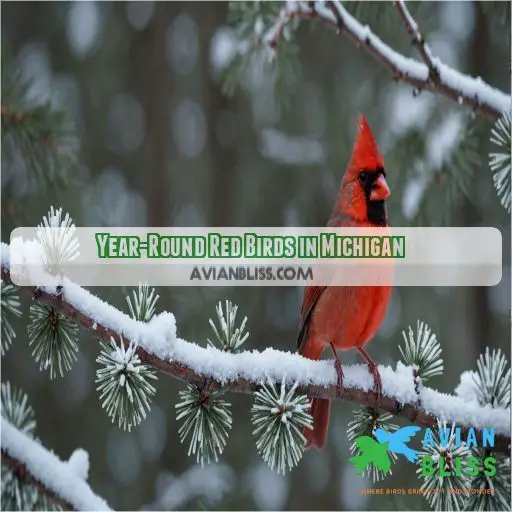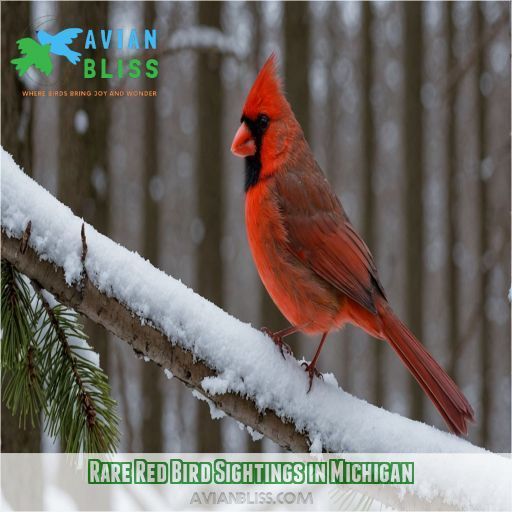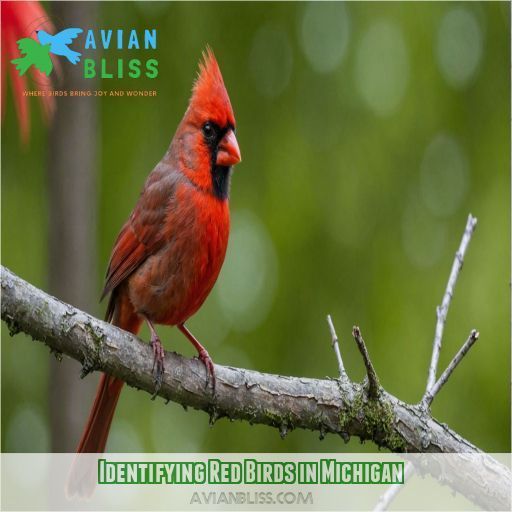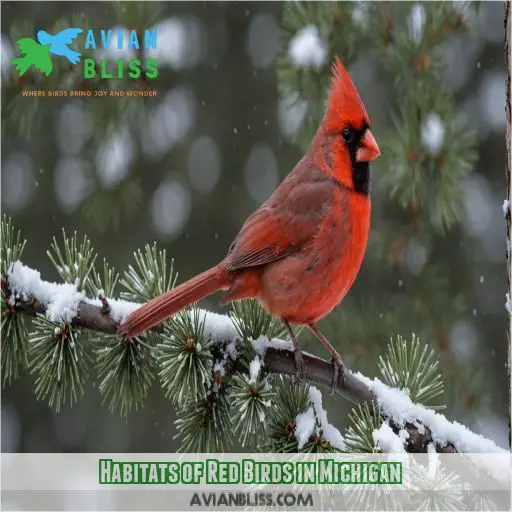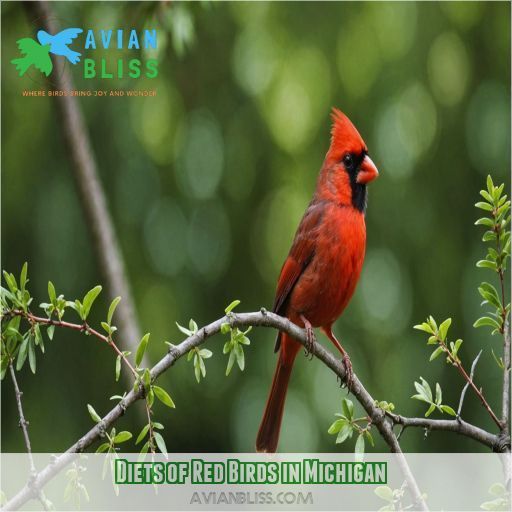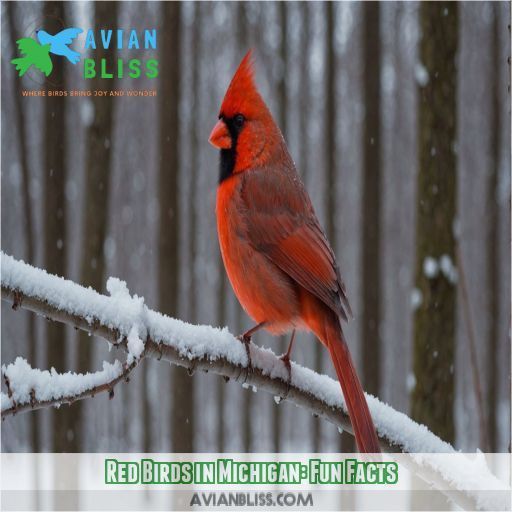This site is supported by our readers. We may earn a commission, at no cost to you, if you purchase through links.
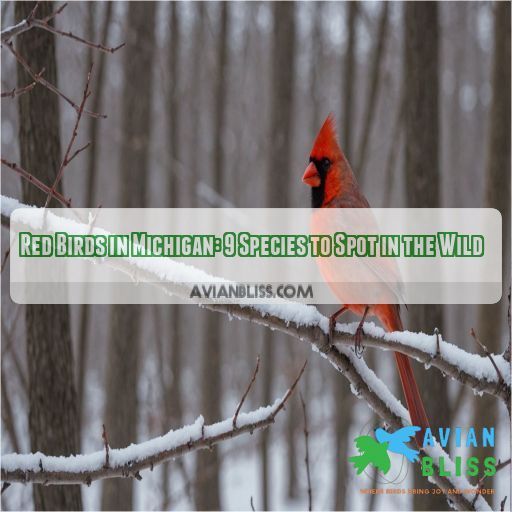
You might also spot the American Robin, with its orange-red breast, and the Common Redpoll, especially during winter.
Read on to discover more about these beautiful birds and how to identify them.
Table Of Contents
- Key Takeaways
- Year-Round Red Birds in Michigan
- Migratory Red Birds in Michigan
- Rare Red Bird Sightings in Michigan
- Identifying Red Birds in Michigan
- Habitats of Red Birds in Michigan
- Diets of Red Birds in Michigan
- Red Birds in Michigan: Fun Facts
- Attracting Red Birds to Your Backyard
- Red Birds in Michigan: Conservation Status
- Frequently Asked Questions (FAQs)
- What is the red bird in Michigan that is not a cardinal?
- What bird is red but not a cardinal?
- What is the most common red bird?
- What is the big red headed bird in Michigan?
- Whats the best birdseed for red birds?
- Can you attract red birds with fruit?
- Are there red birds in Michigan all year?
- Do red birds migrate?
- Are there endangered red birds in Michigan?
- Conclusion
Key Takeaways
- Michigan is home to a variety of vibrant red birds, each with its own unique characteristics and habits.
- The Northern Cardinal, with its bright red feathers and distinctive song, is a common year-round resident and the official state bird.
- Red birds have diverse diets, including seeds, fruits, insects, spiders, berries, and nectar; sunflower seeds and nyjer seeds are particularly attractive to them.
- Bird enthusiasts can attract red birds to their backyards by offering the right food, such as sunflower seeds and berries, and creating habitats with conifer trees and berry plants.
Year-Round Red Birds in Michigan
Whether you’re a seasoned birder or a novice, Michigan’s year-round red birds offer a stunning sight. From the vibrant Northern Cardinal to the elusive Red Crossbill, these feathered friends add a splash of color to the state’s landscapes throughout the year.
Northern Cardinal
The Northern Cardinal is a year-round resident of Michigan, easily spotted by its vibrant red feathers and black facial markings.
Males sport a bright red coat, while females are more subdued with light brown feathers and red highlights.
These birds are common visitors to backyards and bird feeders, where they enjoy a variety of seeds and fruits.
Their distinctive song and colorful appearance make them a favorite among bird enthusiasts.
Keep an eye out for their unique nesting habits and song variations, and you’re sure to enjoy the company of these friendly backyard birds.
Purple Finch
The Purple Finch is a colorful character that’s more common in northern Michigan.
With a reddish-purple head and breast, it’s a finch that’s hard to miss.
These birds breed in Canada and then head to the eastern states for winter, so you might spot them in Michigan all year round.
They’re partial to evergreen forests, where they feed on seeds, buds, nectar, and berries.
If you want to attract them to your feeder, offer some black oil sunflower seeds – they’re a favorite snack for these finches.
House Finch
The House Finch is a common sight in Michigan, especially in the southern parts of the state. These adaptable birds can make their homes in a variety of habitats, from parks to farms, forest edges, and even your own backyard.
Males sport a rosy red head and breast, while the females are a more subtle brown with streaks. Keep an eye out for their notched tails and conical beaks as they flit about.
House Finches are known for their love of bird feeders. Fill yours with black oil sunflower seeds or nyjer seeds, and you might just spot these friendly finches perching on tube or platform feeders.
Red Crossbill
The Red Crossbill is a fascinating year-round resident of Michigan, with some unique characteristics. Here’s what you should know about this colorful bird:
- Appearance: The Red Crossbill is easily identified by its colorful plumage. Males sport a vibrant red hue with darker wings and tails, while females are a beautiful mix of yellow and brown.
- Diet: As the name suggests, conifer seeds are this bird’s main diet. They forage in flocks, moving from tree to tree.
- Mating and Vocalizations:
- Migration and Conservation: More commonly spotted in fall and early winter, Red Crossbills are widespread in northern and western states year-round and migrate to eastern states in winter.
Migratory Red Birds in Michigan
While some red birds are year-round residents of Michigan, others migrate through the state at different times of the year. In this section, we’ll focus on three migratory species that you might be lucky enough to spot during certain seasons.
Scarlet Tanager
| Characteristics | Male | Female |
|---|---|---|
| Plumage | Bright scarlet with black wings and tail | Greenish-yellow with dark wings and tail |
| Size | 7 1/2" (19 cm) | 7 1/2" (19 cm) |
| Beak | Thick, silver/gray | Thick, silver/gray |
| Song | Rich, burry | Chick-burr call note |
| Habitat | Deciduous forests, mixed pine-oak woods | Deciduous forests, mixed pine-oak woods |
Summer Tanager
The Summer Tanager is a rare sight in Michigan, with a preference for the coast and southern regions.
Males sport bright red feathers, while females are a vibrant yellow.
After breeding in the south and east, they migrate to Central and South America.
These birds are adept at snatching bees and wasps mid-flight in open woodlands, and they’re drawn to berry bushes and fruit trees.
Hepatic Tanager
The Hepatic Tanager is an elusive bird in Michigan, with only two sightings in the last decade. These migratory birds breed in the southwestern states and Mexico before flying to Central and South America. They’re mountain dwellers, favoring pine or pine and oak woodlands. Their diet is varied, including insects, spiders, and berries like cherries and grapes.
Rare Red Bird Sightings in Michigan
While some red birds in Michigan are common sights, others are elusive and rarely spotted. In this section, we’ll explore two of these rare red birds that you might be lucky enough to glimpse in the wild.
Painted Bunting
Now, let’s talk about a rare bird that might just make your day if you’re lucky enough to spot it.
The Painted Bunting is a rare visitor to Michigan, but keep your eyes peeled in spring and summer.
Males are like flying rainbows, with red undersides, blue heads, green wings, and backs.
Females are a bright yellow-green.
These colorful birds breed in a few states in the south-central and southeast before migrating to Central America.
You’ll find them foraging for seeds and insects in semi-open habitats.
Pine Grosbeak
The Pine Grosbeak is a rare treat for birdwatchers in Michigan.
They are mostly found in Canada, but some venture into Michigan during their wintering period.
Males sport reddish-pink bodies with gray wings and tails, while females are gray with dull orange heads.
Keep an eye out for them in forests of pine, spruce, and fir, where they feed on seeds, fruit, buds, and insects.
Identifying Red Birds in Michigan
- Look for distinctive markings: Many red birds have unique markings that set them apart.
- Take note of the habitat: Different red birds prefer different habitats.
- Listen for their songs: Birds have unique songs and calls that can help with identification.
Habitats of Red Birds in Michigan
Whether you’re a seasoned birdwatcher or a novice nature enthusiast, understanding the habitats of red birds in Michigan is key to spotting these vibrant creatures. From the dense woodlands and forests to the open spaces of parks and farms, each species has its preferred environment, and knowing where to look can make all the difference.
Woodlands and Forests
As you wander through Michigan’s forests, keep your eyes peeled for these vibrant red birds. From the majestic Northern Cardinal to the elusive Scarlet Tanager, these birds offer a stunning display of nature’s beauty.
| Bird | Habitat | Diet |
|---|---|---|
| Northern Cardinal | Woodlands, Forests | Seeds, Fruits, Insects |
| Purple Finch | Evergreen Forests | Seeds, Buds, Nectar, Berries |
| Red Crossbill | Coniferous Forests | Conifer Seeds |
| Scarlet Tanager | Eastern Forests | Berries, Insects |
| Hepatic Tanager | Pine or Pine-Oak Woodlands | Insects, Spiders, Berries |
Parks and Farms
Not all red birds in Michigan stick to the woods. Some, like the adaptable house finch, can be spotted in parks and farms. These birds are common throughout the state, so keep an eye out for the males’ red heads and breasts. Females are brown-streaked, blending in with the surroundings.
Backyards and Feeders
Your backyard could be a bird haven with the right setup. Some species, like the Northern Cardinal, House Finch, and American Robin, are common backyard visitors.
Bird feeders and baths are great additions to your yard. Different feeder types include tube, hopper, and platform feeders. You can also DIY your own feeders with ideas from Pinterest.
Sunflower seeds, peanut hearts, and millet attract a variety of birds. Nyjer seeds are perfect for smaller birds like finches and redpolls.
Mountain Ranges
If you’re keen to spot some rare red birds, grab your binoculars and head for Michigan’s mountain ranges.
The Hepatic Tanager, a vibrant red bird with a touch of gray on its back, is typically found in mountainous regions with pine or pine and oak woodlands.
This rare bird is a treat to spot, with only a couple of sightings in Michigan over the past decade.
Diets of Red Birds in Michigan
If you’re curious about what those vibrant red birds in Michigan are munching on, you’re in the right place. From seeds to insects, berries to buds, let’s take a closer look at the dietary preferences of these colorful feathered friends.
Seeds and Fruits
When it comes to seeds and fruits, these red birds have their preferences.
The Northern Cardinal, for instance, will happily feast on a variety of seeds, fruits, and insects.
Meanwhile, the Purple Finch has a taste for seeds, buds, nectar, and berries.
And let’s not forget the House Finch, which shares the Cardinal’s love for seeds and fruits, but also enjoys a good insect hunt.
Insects and Spiders
While seeds and fruits form a large part of their diet, red birds in Michigan also feast on insects and spiders. The predator-prey relationship between birds and these creepy crawlies is fascinating. Picture a Vermilion Flycatcher snatching a spider from its web or a Northern Cardinal gobbling up insects in your backyard. It’s a bird-eat-bug world out there!
Berries and Nectar
Some red birds, like the Scarlet Tanager, Summer Tanager, and Hepatic Tanager, have a preference for berries. The Scarlet Tanager, for instance, goes for blackberries, raspberries, and huckleberries. The Summer Tanager and Hepatic Tanager also share a love for berries, especially during their migratory journeys.
The Ruby-Throated Hummingbird, a migratory visitor to Michigan, enjoys nectar from flowers.
Conifer Seeds
Conifer seeds are a favorite snack for some red birds in Michigan. The Red Crossbill, for instance, is specially adapted to extract seeds from conifer cones. These clever birds use their unique crossed bill to pry open cones and access the seeds inside.
The Common Redpoll, another visitor to Michigan, also enjoys conifer seeds. While they don’t have the same crossbill adaptations, they can still find plenty of seeds to snack on.
Red Birds in Michigan: Fun Facts
There’s more to Michigan’s red birds than meets the eye. Here are some fun facts to impress your friends:
- Cardinals are year-round residents: While some red birds migrate, the Northern Cardinal is a loyal Michigander, sticking around all year.
- Michigan’s state bird: Speaking of cardinals, this vibrant bird is also the official state bird of Michigan, chosen for its beauty and resilience.
- Unique bird songs: Each species of red bird has its own unique song, from cheerful chirps to complex melodies.
- Elusive tanagers: Tanagers, such as the Scarlet, Summer, and Hepatic varieties, are shy birds that prefer the high canopy of forests, making them a challenging but rewarding sight.
- Snow-tunnelers: Common Redpolls are adapted to cold climates and can tunnel into snow for shelter at night—a unique skill!
Attracting Red Birds to Your Backyard
Want to attract vibrant red birds to your Michigan backyard? You’re in luck!
With the right mix of food and habitat, you can entice these colorful creatures to visit your outdoor space.
Sunflower Seeds
Want to draw some colorful characters to your yard? Try scattering sunflower seeds. These seeds are like a neon sign to red birds, especially the Northern Cardinal, Purple Finch, and House Finch.
But be warned, sunflower seeds can get expensive. And if you’re not careful, you might attract more than just birds. Squirrels and other critters will be lining up for the buffet too.
Nyjer Seeds
Nyjer seeds are a favorite of finches and other small birds. These tiny black seeds are high in oil and protein, making them a nutritious snack for your feathered friends. They’re especially popular during winter when natural food sources are scarce.
To attract finches to your yard, invest in a Nyjer seed feeder. These specialized feeders have small ports that dispense the tiny seeds, preventing waste. You can also mix Nyjer seeds with other birdseed to create a finch-friendly blend.
Berry Plants
Michigan’s red birds have a sweet tooth, and you can attract them to your backyard with berry plants. Here are some tips to create a berry-licious buffet:
- Plant a variety of berry bushes, such as blackberry, raspberry, and huckleberry, to cater to different species.
- Time your plantings to make sure you have a steady supply of berries throughout the seasons.
- Offer a mix of ripe and unripe berries to cater to different preferences and nutritional needs.
- Provide perching spots near the berry plants to make the birds feel safe while they feast.
Conifer Trees
If you’re keen on attracting red birds to your backyard, consider planting conifer trees. These evergreens are a natural magnet for our feathered friends, especially the Red Crossbill, which feeds on their seeds. The key to success lies in the availability of conifer seeds, so keep an eye out for trees with plenty of cones.
But why stop at seeds? Think like a bird and consider the bigger picture. Red Crossbills are social butterflies, flocking together to forage for food. They’re also fans of conifer forests, so if you’ve got the space, create a mini forest habitat with a variety of conifer species. Just make sure your trees are healthy and strong, providing ample food and shelter for these vibrant visitors.
Red Birds in Michigan: Conservation Status
Now that you’ve brushed up on the different species of red birds in Michigan, let’s shift our focus to their conservation status. Are these vibrant creatures thriving, or do they need our help?
We’ll explore the endangered and threatened species among Michigan’s red birds, as well as those that are considered species of least concern. Understanding their conservation status is key to ensuring these birds continue to grace our backyards and wild spaces for years to come.
Endangered Species
Sadly, some red bird species in Michigan are endangered. Habitat loss and climate change are the main threats, with human impact also playing a role. The painted bunting and glossy ibis are two wetland birds facing these challenges. Conservation efforts are key to protecting these species and their habitats.
Threatened Species
While none of Michigan’s red birds are currently listed as threatened, it’s important to be mindful of the challenges they face. Habitat loss and climate change are the main threats to bird populations worldwide.
To protect these vibrant birds:
- Support local conservation organizations working to preserve their habitats.
- Advocate for sustainable practices that minimize habitat destruction.
- Educate yourself and others about the impact of climate change on bird populations.
Species of Least Concern
Most of the red birds in Michigan are species of least concern, meaning their populations are stable and not under immediate threat. This includes the Northern Cardinal, Purple Finch, House Finch, Common Redpoll, Red Crossbill, Scarlet Tanager, and Pine Grosbeak. While some of these species face challenges like habitat loss or competition with other bird species, their overall numbers remain healthy.
It’s important to protect these birds so they keep thriving.
Local Birding Clubs
If you’re keen to learn more about red birds in Michigan, joining a local birding club is a great way to connect with like-minded folks and gain insider knowledge. Here’s what you can expect:
- Club Meetings: Get-togethers are a chance to swap stories, share expertise, and plan outings.
- Bird Walks: Guided walks offer a fun, social way to spot species and learn from experienced birders.
- Membership Benefits: Many clubs offer perks like newsletters, online resources, and discounts at bird-friendly businesses.
- Conservation Efforts: Be part of initiatives to protect bird habitats and advocate for at-risk species.
- Local Experts: Tap into a wealth of knowledge from seasoned birders who know the best spots and can help identify tricky species.
Frequently Asked Questions (FAQs)
What is the red bird in Michigan that is not a cardinal?
You might spot a scarlet tanager, red-headed woodpecker, or white-winged crossbill. There’s also the rose-breasted grosbeak, pine grosbeak, and common redpoll.
What bird is red but not a cardinal?
If you’re not looking at a cardinal, you might be seeing a red-headed woodpecker, a red-bellied woodpecker, or even a ruby-throated hummingbird.
What is the most common red bird?
If you’re wondering about red birds, the Northern Cardinal is a good guess. They’re well-known in North America for their bright red plumage and melodic chirping. Scarlet Tanagers are another red bird, but they prefer to hide in treetops.
What is the big red headed bird in Michigan?
You’re probably thinking of the Red-headed Woodpecker. Males have a red head, black and white bodies, and black and white wings. Females are gray-brown.
Whats the best birdseed for red birds?
You’ve got tons of choices when it comes to birdseed. To attract red birds, try black oil sunflower seeds, safflower seeds, or thistle seeds. Sunflower seeds are a safe bet, attracting tons of birds.
Can you attract red birds with fruit?
Red birds are drawn to red berries or fruit with red on the leaves or stems. Try a halved orange, apple slices, raisins, grape jelly, or grapes.
Are there red birds in Michigan all year?
Yes, there are a few red birds in Michigan all year. You can spot House Finches, Northern Cardinals, and Red Crossbills.
Do red birds migrate?
Some red birds, like the Northern Cardinal, don’t migrate. They stay put all year, adapting to colder climates and finding food sources like bird feeders.
Are there endangered red birds in Michigan?
No red birds in Michigan are currently listed as endangered. However, the Hepatic Tanager is very rare, with only two sightings in the state over the last decade.
Conclusion
Michigan’s diverse landscapes are home to vibrant red birds, each a dazzling gem in the wild.
From the stately Northern Cardinal to the elusive Painted Bunting, you’re in for a colorful adventure.
Whether you’re a seasoned birder or a novice, the thrill of spotting these crimson creatures is undeniable.

